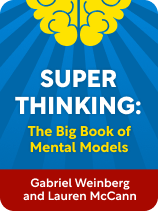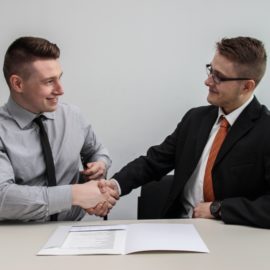

This article is an excerpt from the Shortform book guide to "Super Thinking: The Big Book of Mental Models" by Gabriel Weinberg and Lauren McCann. Shortform has the world's best summaries and analyses of books you should be reading.
Like this article? Sign up for a free trial here.
What is a sustainable competitive advantage? What can you do to gain a competitive edge in your market?
In essence, a sustainable competitive advantage is a long-term edge over competitors that you can exploit. For example, Tesla has derived a sustainable competitive advantage by producing its own car batteries, which consistently cuts costs while delivering higher-quality batteries than the competition.
Here are some tips for building a sustainable competitive advantage.
Finding Secrets
Weinberg and McCann suggest that one key to building a sustainable competitive advantage is finding secrets. Typically, these are little-known pieces of information that can yield high-leverage opportunities. For instance, in the late ’90s and early 2000s, Canadian sports bettor Bob Voulgaris used data analytics to identify edges when betting, as casinos weren’t yet systematically using analytics. From this secret, he netted millions.
However, secrets can also be well-known information deemed too risky to act upon. For example, the possibility of electric cars was well-known before Tesla; in 1900, they were even the most-purchased car type. Yet, because it was widely assumed that they were financially untenable, traditional automakers decided to focus on gas-powered cars. By challenging this assumption, Tesla exploited a widely known “secret” to become a trillion-dollar company.
While there’s no foolproof method to finding secrets, Weinberg and McCann encourage intellectual curiosity and openness to new ideas from unexpected places. More concretely, they recommend surrounding yourself with people from other fields, since secrets in one field are often well-known in another.
| Further Steps for Finding Secrets Weinberg and McCann cite Peter Thiel’s book, Zero to One, as the origin of their proposal to find secrets. In the book, Thiel offers several additional steps for finding secrets: – Believe that secrets are out there. – Resist the temptation to believe that we’ve already uncovered all the relevant secrets. Examine questions that mainstream thinkers seem to ignore or deem worthless. These questions often reveal secrets. – Be willing to look foolish by questioning conventional assumptions. Adherence to these assumptions can inhibit our ability to unearth secrets Historically, the Wright Brothers exemplified these steps in developing the first successful airplane. By questioning the conventional assumption that flying was technologically impossible, they discovered secrets—like using wing warping to generate more lift—which culminated in a successful flight in December of 1903. |
Reaching Product/Market Fit
Despite their importance, Weinberg and McCann argue that secrets alone can’t guarantee success. Rather, they help us design a product that fills a gap in the market and consequently becomes in demand. In other words, secrets help us develop product/market fit.
Product/market fit is pivotal in determining which of various similar products will thrive. After all, although over 170 companies currently produce smartphones, only one of them is Apple. More generally, the first product that reaches perfect product/market fit is likely to succeed.
(Shortform note: Products that attain product/market fit still undergo the product life cycle, often culminating in market decline, where they fall out of favor with consumers. For this reason, it’s important to continue adapting even after reaching product/market fit, or your success could be short-lived. Once again, it’s key to remember Simon Sinek’s advice in The Infinite Game: treat business as an infinite game, where the goal is to continue playing.)
Customer Development
To achieve product/market fit, Weinberg and McCann advocate engaging in customer development. Simply put, this involves experimenting with your customer base so that you best understand their perspective. By keeping this perspective in mind when creating your product, it’s more likely that your product will be attuned to customers’ wants and needs.
For example, customer development might occur via focus groups, where random samples of customers discuss your product before its launch and share impressions. Harkening back to Part 2, this process lets you de-risk assumptions about your product’s viability and potential. By incorporating the feedback gleaned from customers into further iterations of your product, Weinberg and McCann claim that you’ll be able to quickly reach product/market fit.
(Shortform note: Weinberg and McCann discuss customer development in the context of specific products. However, customer development is also applicable to entire business models. In particular, start-ups can use customer development to determine the strengths and weaknesses of their potential business models. For example, start-ups might run surveys to assess consumer needs, and develop business models to meet those needs.)
| Though sustainable competitive advantage is widely touted as the holy grail of business, some recommend instead pursuing transient advantages, short-term edges that collectively yield long-term success. In particular, they argue that sustainable competitive advantage is unrealistic, as globalization and increased digitization have made it harder to derive long-term edges. So, rather than pursuing sustainable advantages, they recommend seeking short-term advantages to exploit. For example, Amazon gained transient advantage by offering incrementally more products: It started as a platform for selling books, then added CDs, then expanded to products like toys and electronics, and eventually launched a streaming service. None of these advantages were sustainable—other companies also sold CDs and goods online, and other streaming services emerged—but each one provided a short-term advantage that Amazon exploited for a certain period. (However, these short-term edges may have collectively yielded a long-term edge, because the sheer range of products available on Amazon is now a sustainable competitive advantage.) |
Minimize Damage from Conflict
Even with sustainable competitive advantages, successful companies must be wary of conflict with competitors. To that end, Weinberg and McCann offer mental models designed to either avoid conflict altogether or minimize fallout once it begins.
Deterrence
To avoid conflict in the first place, deterrence is a useful strategy. This involves employing a threat to deter the opposition from engaging in conflict. Parents of rebellious children, for example, might deter them from sneaking out by threatening to ground them if caught.
As one particularly useful form of deterrence, Weinberg and McCann recommend the carrot and stick model. This model consists of some form of negative punishment (the stick), alongside some form of positive reinforcement (the carrot). For example, a professor might deter students from skipping class by threatening to reduce their grades while also promising a grade boost for those with perfect attendance. By using this model, you reap the benefits of both punishment and positive reinforcement, which increases the likelihood that conflict will be avoided.
(Shortform note: The efficacy of positive reinforcement versus punishment varies depending on your desired goal. Generally, positive reinforcement is more effective at encouraging action, while punishment is more effective at encouraging inaction. However, some argue that this asymmetry doesn’t hold for children, for whom rewards work consistently better.)
Containment
When deterrence fails, the next step is containment. In short, containment involves taking steps to prevent further escalation and minimizing the damage. For example, if you’re a food distributor who’s realized that customers purchasing a particular food product are falling ill, you might recall that product to stop further damage.
Weinberg and McCann argue that, in the long term, containment can prevent further harm, because conflict left unchecked can start a domino effect of further damage. For example, Blockbuster failed to contain initial conflict with Netflix, with Blockbuster CEO John Antioco spurning a $50 million offer to purchase Netflix. This failure to contain the budding problem created a domino effect, ultimately leading Blockbuster to declare bankruptcy in 2010.
(Shortform note: While containment can prevent domino effects, it can also have adverse consequences. For example, consider the historical paradigm of containment: President Harry Truman’s strategy in the Cold War to prevent the expansion of the Soviet Union. To prevent communism from gaining influence, Truman provided military and economic assistance to countries at risk of Soviet invasion. However, scholars allege that Truman’s containment strategy inadvertently inhibited diplomacy and the possibility of dialogue with the Soviets. Containment, then, isn’t always a risk-free approach.)
Appeasement
If all else fails, Weinberg and McCann recommend appeasement, even if you have to make significant concessions to your opposition. For example, imagine you’re locked in a legal battle with competitors that threatens to harm your company’s reputation. In this case, it might be worthwhile to make a settlement offer to appease them. By doing so, you make a short-term concession, but prevent possible long-term catastrophe.
(Shortform note: The most famous historical example of appeasement was actually a flop: In 1938, British Prime Minister Neville Chamberlain signed the Munich Agreement, licensing the German annexation of Sudetenland to appease Germany and avoid further conflict. This decision famously proved moot: Conflict ensued nonetheless. Though the Munich Agreement is often cited as a cautionary tale against appeasement, this may be a case of hindsight bias—thinking an outcome was easier to predict in hindsight than it actually was.)

———End of Preview———
Like what you just read? Read the rest of the world's best book summary and analysis of Gabriel Weinberg and Lauren McCann's "Super Thinking: The Big Book of Mental Models" at Shortform.
Here's what you'll find in our full Super Thinking: The Big Book of Mental Models summary:
- How to elevate your everyday reasoning and decision-making skills
- Why you shouldn't rely on intuition when making decisions
- How to deter you opposition from engaging in conflict






